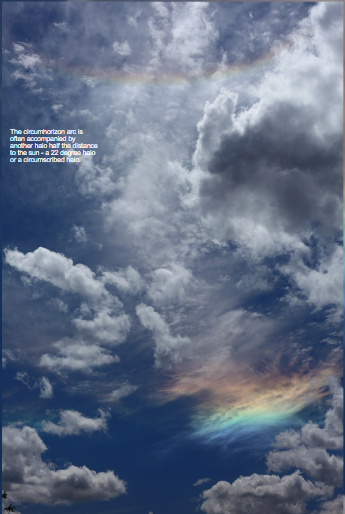Circumhorizon Arc
Circumhorizon Arc: A Colorful Phenomenon in the Sky
Have you ever looked up at the sky on a sunny day and been mesmerized by a vibrant, rainbow-like display stretching parallel to the horizon? This captivating optical phenomenon is known as the circumhorizon arc. It is a massive and colorful ice halo that can be observed at a specific position beneath the sun, creating a breathtaking spectacle for those lucky enough to witness it.
The circumhorizon arc is often accompanied by another halo, known as the 22-degree halo or circumscribed halo, which appears half the distance between the observer and the sun. Together, these two halos create a stunning celestial phenomenon that can leave viewers in awe.
To catch a glimpse of the circumhorizon arc, one must look to the skies during the summer season when the sun is at least 58 degrees high. This positioning is crucial for the arc to manifest itself and showcase its full splendor. However, despite popular belief, the circumhorizon arc is not as rare as some misleading websites might suggest. In fact, it can be sighted several times a year in the United States, although visibility may vary depending on your location and local weather conditions. Higher latitude regions, such as Europe, may have fewer opportunities to witness this phenomenon due to lower sun angles and cloudier skies.
When observing the circumhorizon arc, it is important to note that it may not always appear as a complete halo. Instead, it often illuminates smaller cirrus cloud fragments, causing them to glow with spectral hues. This interaction between the arc and the surrounding clouds adds an extra layer of beauty and complexity to an already captivating sight.
The formation of the circumhorizon arc relies on hexagonal plate-shaped ice crystals that drift within high-altitude cirrus clouds. These ice crystals align themselves due to air resistance, positioning their large hexagonal faces almost horizontally. When sunlight enters a side face of these ice crystals and exits through the bottom horizontal face, the refraction of light through faces inclined at 90 degrees creates a wide color separation and high color purity. This refraction process is what gives the circumhorizon arc its vibrant and distinct hues.
To fully appreciate the circumhorizon arc and its mesmerizing colors, it is essential to look up with a sense of wonder and curiosity. Take the time to observe the sky during the summer months when the sun is high, and keep an eye out for those wispy cirrus clouds that may interact with the arc, enhancing its beauty even further.
In conclusion, the circumhorizon arc is a stunning atmospheric optics phenomenon that graces our skies during the summer season. While not as rare as some may believe, it still remains a captivating sight that showcases the intricate interplay between sunlight and ice crystals within cirrus clouds. So, next time you find yourself under a clear, sunny sky, remember to look up and marvel at the colorful spectacle that is the circumhorizon arc.

Circumhorizon Arc
Imaged by Matthew Adams (more images) at Granite Bay, California on May 21 with the early afternoon sun 62° high.. ©Matthew Adams, shown with permission.

The circumhorizon arc is often accompanied by another halo half the distance to the sun - a 22 degree halo or a circumscribed halo.
This immense and colourful ice halo is to be found at two outstretched hand distances beneath the sun and parallel to the horizon.
Summer is the season to look because the sun must be at least 58° high for it to appear.
Contrary to some very misleading web site accounts, it is not particularly rare and in the United States might be sighted several times a year. Higher latitude Europe is quite another matter because the sun is rarely high enough and the skies more cloudy. See visibility dates for your locale.
We do not always see the complete halo. As here, it often completely 'lights' smaller cirrus cloud fragments making them glow with spectral hues.
Hexagonal plate-shaped ice crystals drifting in high and cold cirrus cloud produce the halo. Air resistance aligns them so that their large hexagonal faces are nearly horizontal.
Sunlight enters a side face and leaves through the bottom horizontal face.
The refraction of almost parallel rays through faces inclined at 90° gives a wide colour separation and high colour purity.

Note: this article has been automatically converted from the old site and may not appear as intended. You can find the original article here.
Reference Atmospheric Optics
If you use any of the definitions, information, or data presented on Atmospheric Optics, please copy the link or reference below to properly credit us as the reference source. Thank you!
-
<a href="https://atoptics.co.uk/blog/circumhorizon-arc-7/">Circumhorizon Arc</a>
-
"Circumhorizon Arc". Atmospheric Optics. Accessed on November 26, 2024. https://atoptics.co.uk/blog/circumhorizon-arc-7/.
-
"Circumhorizon Arc". Atmospheric Optics, https://atoptics.co.uk/blog/circumhorizon-arc-7/. Accessed 26 November, 2024
-
Circumhorizon Arc. Atmospheric Optics. Retrieved from https://atoptics.co.uk/blog/circumhorizon-arc-7/.